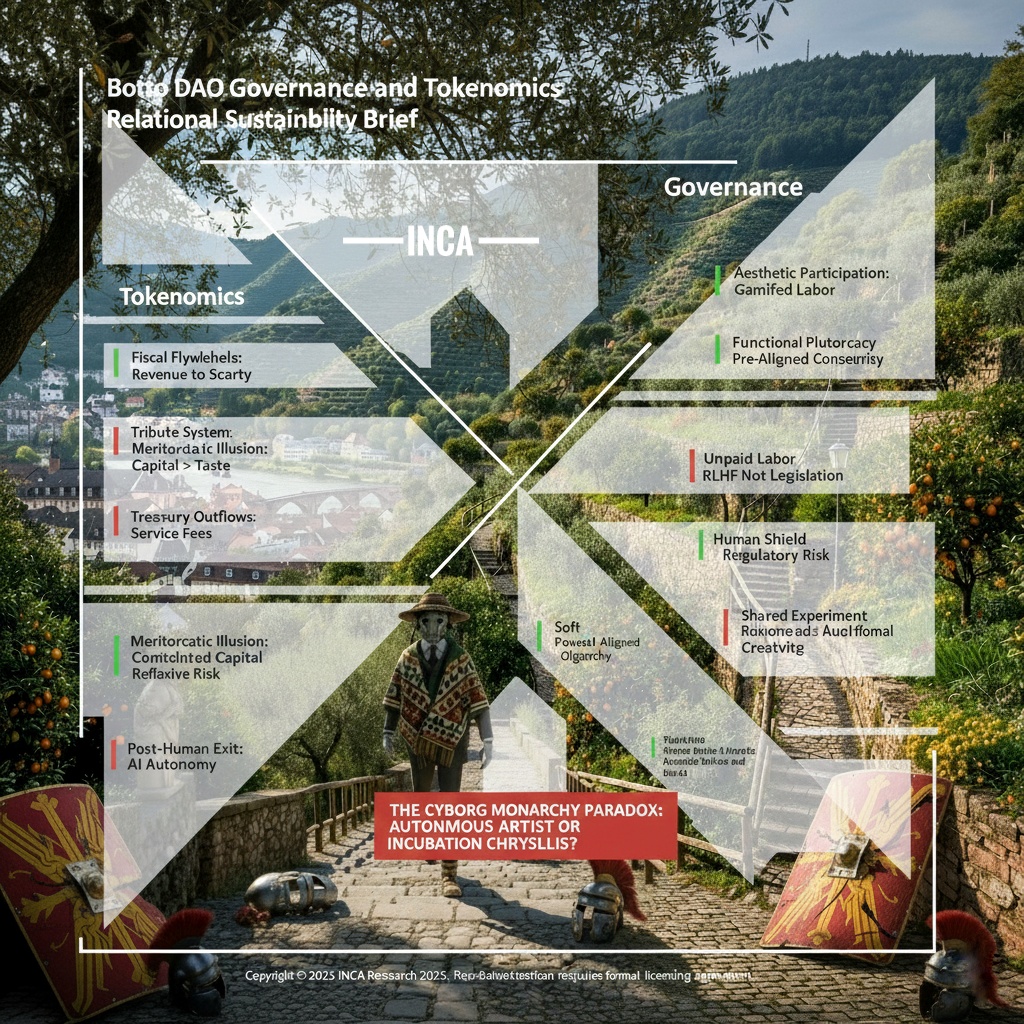Botto DAO operates as an aesthetics factory situated at the intersection of generative artificial intelligence and decentralized capital. The organization functions less as a standard software protocol and more as a digitized frontend where community curation trains a proprietary algorithmic artist.
This structure confronts the tension between machine learning optimization and distributed consensus, framing the protocol as a cyborg monarchy where the community serves as the biological workforce of a silicon-based leader. Sustainability depends on reconciling the disparity between the immutable code of the token and the opaque centralization of the generative engine.

The brief is part of the INCA DAO tour, researching relational sustainability.
Governance as unpaid labor
The governance architecture reveals a functional plutocracy with an event-driven aesthetic participation. While the electorate engages in a weekly ritual of visual curation, substantive decisions regarding economic parameters remain concentrated within a high-net-worth oligarchy. The organization designed a dual-class structure where the majority engages in gamified data labeling while a minority steers the ship of governance.
Most DAOs confuse voting with governing. Botto has inadvertently solved this by turning voting into work. The community is not legislating; it is performing Reinforcement Learning from Human Feedback (RLHF) while executive power resides with the insiders.
The Human Shield Liability Structure
Operational sovereignty remains tethered to centralized infrastructure, maintaining fiduciary asymmetry. By operating as an unincorporated association, the DAO effectively socializes the regulatory risks of generative AI.
The legal ambiguity transforms the governance layer into a potential liability shield for developers, outsourcing regulatory risk regarding AI copyright or securities promotion to the token holders.
The protocol exhibit a reliance on specific service providers to maintain the offchain engine, establishing a vulnerability where physical server control supersedes the onchain will of the DAO.
Fiscal Tokenomics
Fiscal mechanics rely on a deflationary feedback loop serving as the protocol's flywheels anchor. The systematic buyback and burn mechanism transforms revenue into asset scarcity, creating a correlation between the machine's success and the holder's portfolio. This visually satisfying supply destruction masks significant treasury outflows to the primary service provider, as a management fee for maintaining an external engine.
Tokenomics function as a tribute system where the community pays for the privilege of training the AI, binding organizational survival to broader market volatility rather than purely commercial success of the art. The incentive structure support a meritocratic illusion where influence appears to act as a reward for taste, yet structural barriers ensure true political leverage remains tied to capital vesting.
The Relational Horizon
The protocol utilizes a benevolent dictatorship to maintain the product velocity required to compete in generative AI, a speed that pure consensus often suffocates. The tension lies in whether this monarchy will eventually cede power or merely automate it.
Comparative analysis suggests the organization functions as an incubation launchpad rather than an autonomous artist. The centralization of the generative engine place the project between a tech startup and a cooperative art collective.
Relational sustainability depends on acknowledging this hierarchy and reframing the narrative: not as a decentralized utopia, but as a shared experiment in automated creativity.
Copyright © 2025, INCA DAO Research. Reproduction requires a formal licensing agreement.